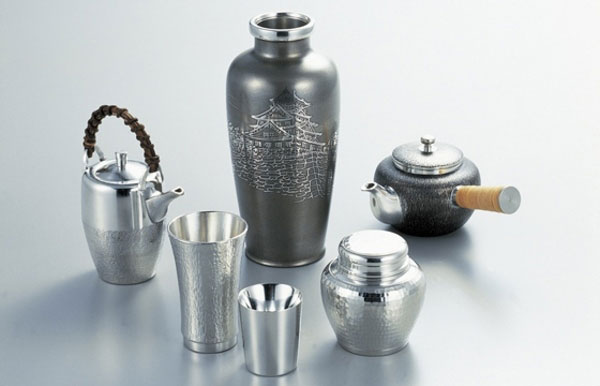 Photo:Osaka Prefecture
Photo:Osaka Prefecture
- Metal works
- Osaka
Osaka naniwa pewterware Osaka naniwa suzuki
Delicate and detailed tinware
handmade by experienced artisans
Description
What is Osaka naniwa pewterware ?
Osaka naniwa pewterware (called Osaka naniwa suzuki in Japanese) is a metalwork produced in and around the city of Osaka, Osaka prefecture. In the past, tin mined in Japan was used, but today it is imported mainly from Thailand and Indonesia. This craft has subtle differences even between pieces made by the same craftsman, because each piece is completely handmade as tin is a relatively soft metal and difficult to process by machine. Tin is a very stable and durable metal. It is said that tin mellows the taste of sake, resulting in the production of beautiful sake drinking sets as well as flower vases. The hand-engraved concave-convex patterns inside a beer mug generates longer-lasting beer foam, and the rim with a certain thickness gives a smooth and pleasant feeling when drinking. Products such as tea canisters are turned on a lathe. The highly precise cutting using a lathe gives products an airtightness that prevents moisture and oxidation, which is particularly ideal for preserving tea.
History
The history of tinware production dates back to the Asuka period (538-710). Some tin pieces can be found in the Shosoin Repository*. Tin used to be valued like gold and silver and was only allowed in limited settings such as for Imperial court dinnerware and ritual articles. A document called Jinrin-kinmouzui references the existence of tinware craftsmen in Kyoto and the Kansai region in the early Edo period (1603-1868). According to a document called Naniwa-suzume, production of tinware in Osaka began in 1679, and by the mid Edo period, tinware was produced in Kamigata (Osaka, Kyoto, Nara, Shiga and Hyogo) where distribution functions were good. In and after the mid Edo period, this region became the largest production area in Japan, and around the end of the Taisho period (1912-1926), there were close to fifty tinware manufacturers and over three hundred artisans. However, upon the start of World War II, many craftsmen were drafted for military service and obtaining material became difficult, resulting in a production crisis. While Osaka naniwa pewterware underwent difficult times, it was able to revive production and be recognized by the Minister of International Trade and Industry in 1983 as a traditional craft. *The Shosoin Repository is a building located in Nara, a former capital of Japan, that has been around since the eighth-century. It not only has a collection of treasures dating back to the Silk Road, it also preserves over 10,000 hand-written documents all dating from the Nara period (710–784). Today the repository is under the control of the Imperial Household Agency.
General Production Process
- 1. Raw materials
In recent years, Osaka naniwa pewterware uses tin mainly imported from Thailand, Malaysia, and Indonesia.
- 2. Molding
Tin melts at a low temperature of 230℃ (446℉), so the options of heat source can include city gas. After melting tin blocks in a pot, a ladle is used to pour the liquid into a mold made of cement, clay, or metal. Melted tin hardens quickly if the mold is a low temperature so the melted tin needs to be repeatedly poured in and out of the mold,and back to the pot to heat the mold to the proper temperature.
The temperature is adjusted and the solidified tin is removed from the mold at the proper timing. Any excess tin formed around the edge is removed. - 3. Cutting Making a round tin requires cutting and shaping on a turning lathe.The artisans' skills make it possible to precisely align the opening of a tea caddy with the lid at this stage. For long slender objects like vases and objects that cannot be made in one mold, the pieces molded seperately are cut on on the inside and outside and welded. Different kinds of planes are used for smoothing, shaping, and finishing the rough surface of the tinware, along with natural sandpaper such as scouring rush and leaves of the oriental elm tree for polishing.
- 4. Intermediate process
This is a process of attaching a handle or spout that cannot be made with a turning lathe. The tinware is cut, bent, and given a hammered finish.
- 5. Patterning
A pattern or design is painted on the surface of the tin with lacquer or enamel. The tinware is then immersed in a nitric acid solution which corrodes the non-painted parts, giving it an uneven finish. After checking the appearance of the design, the surface is washed with water and black or vermilion lacquer is applied and wiped off repeatedly, making the pattern shine and stand out. Patterning is delicate as the degree of corrosion can change depending on the season.
- 6. Final touches
With the lacquer painted surface dried, the tinware needs to be polished with a turning lathe again. The handle, or other parts based on the design is attached at this final stage.
See more Metal works
- Nambu ironware
- Takaoka copperware
- Yamagata cast iron
- Sakai cutlery
- Tokyo silverware
- Echizen cutlery
- Osaka naniwa pewterware
- Tosa cutlery
- Tsubame-tsuiki copperware
- Shinshu Forged Blades
- Banshu-miki cutlery
- Higo inlays
- Echigo-sanjo cutlery
- Echigo-yoita cutlery
- Chiba Artisan Tools
- Tokyo antimony craft































































































































































































































































































